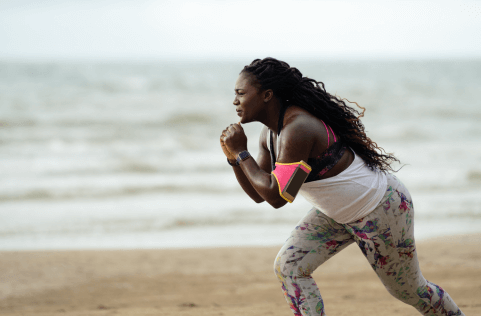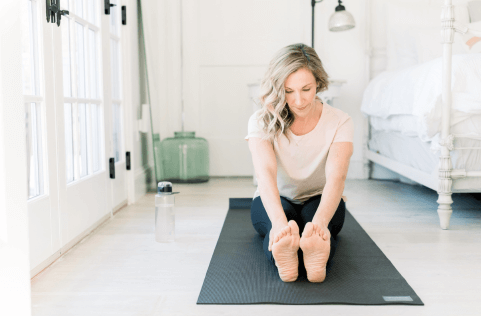We live in a culture that emphasizes exercise as something that is beneficial for health. And, for sure, movement can be health promoting in so many different ways. However, have you ever thought about your relationship to exercise? We talk a lot about relationship to food and how having a negative relationship can impact overall stress levels and health... but what about exercise?
It turns out that having a negative relationship with exercise (which can look different for many people but might include: over-exercise or negative self talk during movement) negatively impacts health by increasing stress hormones and leaving you at a greater risk for injury. Not to mention, having a poor relationship with movement or only feeling inclined to move because you think you *should* does not cultivate a sustainable relationship with exercise. This can lead to stopping and starting many different fitness routines, increased feelings of shame or guilt and a decreased desire to move at all.
So the question becomes... how do I *actually* start to enjoy exercise?
This is a nuanced question. However, something that we talk about frequently (and falls into the principles of Intuitive Eating and Health At Every Size) is joyful movement. Let's dive into what joyful movement is and how we can start feeling more connected to our bodies during exercise.

but first - how is your relationship to exercise?
Let's take a quick second to answer the following questions:
-
Do you exercise to “burn off” something you ate?
-
Do you exercise as a way to punish yourself for overeating?
-
Do you HATE exercise but feel that you HAVE to do it?
-
Do you exercise with the “no pain, no gain” mentality?
-
Are you pushing through pain and risking injury because you feel that you have to?
If you answered “yes” to any of the above questions it’s time to step back and take a good hard look at your relationship with exercise.
Often when we exercise we find ourselves only focusing on external cues such as calories burned, heart rate, pace, and distance.
We allow these external factors or cues to dictate our workout: how hard we push ourselves, how long we exercise for, how far we end up going, etc.
While these external cues may be beneficial in some capacity, such as training for an event, overly focusing on these cues may interfere with our ability to connect with our working muscles before, during, and after exercise. Ask yourself: How is your mood? Your energy level? Do you feel physically different? It’s important to check in with yourself!
When it comes to joyful movement we are starting to take the focus away from the external cues (calories burned, amount of time spent exercising, etc) to more internal cues. This helps us to be able to more fully connect to our bodies and find what feels GOOD! Because when it feels good, we are much more likely to incorporate it in more regularly.

how to experiment with joyful movement
make a list of movement you enjoy (nothing is off limits)
Our first step when thinking about cultivating a more positive relationship with exercise is knowing your options. Start by brainstorming a list of all kinds of movement - leave nothing out! This can include: gardening, dancing, cleaning, stretching, walking. Include any activity that involves moving your body. A fun prompt is thinking about how you used to move as a kid. Were you playing hopscotch? Climbing trees? Biking? Playing sports? What types of activities were exciting for you!
*Side note - if you are having thoughts that only certain activities should "count" as exercise: you are not alone. However, it may be especially important for you to reflect on your intentions with movement. We like to think of it as a piggy bank - all movement is good movement and can contribute to health promotion no matter how "big" or "small" it is.*
start to experiment!
Once you have a solid list of enjoyable forms of movement we can start to experiment. Here’s what to do:
1. Choose an activity that is not very strenuous.
Whatever you choose, focus on connecting to your body in a way that you may not typically be used to. Examples include:
-
- Walking
- Stretching
- Leisurely bike ride
- Restorative Yoga
2. Before you begin, check-in with your body.
-
- How does your body feel?
- How is your energy? Are you tired?
- Do you feel any discomfort at the moment?
3. Then, check-in with your intentions.
-
- Is the choice to move your body coming from a place of body respect?
- Are you moving in an attempt to change or micromanage your body?
- Does the idea of movement add more stress to your day?
4. As you begin moving, continue to focus on how your body feels.
Think about these questions:
-
- Do you feel each muscle working?
- Do you notice your lungs inhaling and exhaling?
- Can you feel your feet on the ground?
- What about your butt in the saddle of the bike?
- Can you feel the wind blowing your hair back?
- Are you noticing the water you’re sipping on as it moves from your mouth to your stomach?
5. Write down your thoughts if you can.
It will help you to remember how you felt before and during physical activity and will help guide you the next time you decide how you want to move.
reflect on your experiment
After you have gone through a movement experiment - check in with yourself. How did it go?
-
Did you maybe notice that your legs felt tired so you slowed down your pace?
-
Or, maybe you noticed your energy levels were high and you were enjoying the breeze on your skin so you extended your activity a bit longer?
-
Did you hold one stretch longer than another because it felt good?
Most importantly - did you enjoy yourself during the process? If yes - what parts of the experience did you enjoy? (The sweat? Being outdoors? The company [were you solo or with a friend]? The music? How you felt after?) If no - what parts did you not enjoy. Keep track of your experience to start to figure out the elements of movement that are more enjoyable for you and the parts that feel more like a chore.
practice practice practice!
Remember... finding joyful movement is a journey! You may struggle on the first few experiments to truly find a type of exercise that you enjoy. And that's OKAY! We want to emphasis that practicing being more tuned into what feels good (and what doesn't) is only going to improve your ability to listen to your body in the long run.
Don’t forget, exercise looks different for every human body. All bodies are different and therefore prefer different types of movement. Avoid putting yourself on the next fad exercise program because you want to have a body that looks just like the celebrity that endorses it. Just like with diets, it’s easy to fall into this trap and feel the need to have to follow a specific prescription for exercise to look a certain way.
All of us have different genetic combinations, how our bodies respond to exercise is also going to look different. Plus, you don’t want to choose an exercise program that makes you feel miserable. Physical activity as a conduit for punishment or pain is NOT what we hope to accomplish here.
Joyful movement is about finding pleasure in how we move our bodies. We can’t argue that regular physical activity is good for us. It boosts mood, increases energy, decreases stress, and improves sleep. Joyful movement is not about compensating for food that we’ve eaten the same way it is not to be done to earn the right to consume certain foods.

how nourishrx can support you
Cultivating a joyful relationship with movement takes time, be gentle with yourself. And if you feel that you need a little more, reach out to us and let us know how we can help.
Comments Off on Embracing Joyful Movement: A Guide to Getting Started